| 1. Tan L, Gurbani D, Weisberg EL, Jones DS, Rao S, Singer WD, Bernard FM, Mowafy S, Jenney A, Du G et al.. (2017) Studies of TAK1-centered polypharmacology with novel covalent TAK1 inhibitors.. Bioorg Med Chem, 25 (4): (1320-1328). [PMID:28038940] [10.1021/op500134e] |
| 2. Thomas R Burkard,Melanie Planyavsky,Ines Kaupe,Florian P Breitwieser,Tilmann Bürckstümmer,Keiryn L Bennett,Giulio Superti-Furga,Jacques Colinge. (2011-01-29) Initial characterization of the human central proteome.. BMC systems biology, 5 (17-17). [PMID:21269460] |
| 3. Becerra, S P SP, Sagasti, A A, Spinella, P P and Notario, V V.. (1995) Pigment epithelium-derived factor behaves like a noninhibitory serpin. Neurotrophic activity does not require the serpin reactive loop.. The Journal of biological chemistry, (27): [PMID:7592790] |
| 4. Becerra, S P SP and 6 more authors.. (1993) Overexpression of fetal human pigment epithelium-derived factor in Escherichia coli. A functionally active neurotrophic factor.. The Journal of biological chemistry, (5): [PMID:8226833] |
| 5. Steele, F R FR, Chader, G J GJ, Johnson, L V LV and Tombran-Tink, J J.. (1993) Pigment epithelium-derived factor: neurotrophic activity and identification as a member of the serine protease inhibitor gene family.. Proceedings of the National Academy of Sciences of the United States of America, (15): [PMID:8434014] |
| 6. Pignolo, R J RJ, Cristofalo, V J VJ and Rotenberg, M O MO.. (1993) Senescent WI-38 cells fail to express EPC-1, a gene induced in young cells upon entry into the G0 state.. The Journal of biological chemistry, (25): [PMID:8473338] |
| 7. Tombran-Tink, J J and 6 more authors.. (1996) Organization, evolutionary conservation, expression and unusual Alu density of the human gene for pigment epithelium-derived factor, a unique neurotrophic serpin.. Molecular vision, (4): [PMID:9238088] |
| 8. Koenekoop, R R and 6 more authors.. (1999) Four polymorphic variations in the PEDF gene identified during the mutation screening of patients with Leber congenital amaurosis.. Molecular vision, (2): [PMID:10398730] |
| 9. Simonovic, M M, Gettins, P G PG and Volz, K K.. (2001) Crystal structure of human PEDF, a potent anti-angiogenic and neurite growth-promoting factor.. Proceedings of the National Academy of Sciences of the United States of America, (25): [PMID:11562499] |
| 10. Petersen, Steen V SV, Valnickova, Zuzana Z and Enghild, Jan J JJ.. (2003) Pigment-epithelium-derived factor (PEDF) occurs at a physiologically relevant concentration in human blood: purification and characterization.. The Biochemical journal, (15): [PMID:12737624] |
| 11. Maik-Rachline, Galia G, Shaltiel, Shmuel S and Seger, Rony R.. (2005) Extracellular phosphorylation converts pigment epithelium-derived factor from a neurotrophic to an antiangiogenic factor.. Blood, (15): [PMID:15374885] |
| 12. Liu, Tao T and 6 more authors.. () Human plasma N-glycoproteome analysis by immunoaffinity subtraction, hydrazide chemistry, and mass spectrometry.. Journal of proteome research, [PMID:16335952] |
| 13. Zody, Michael C MC and 73 more authors.. (2006) DNA sequence of human chromosome 17 and analysis of rearrangement in the human lineage.. Nature, (20): [PMID:16625196] |
| 14. Notari, Luigi L and 12 more authors.. (2006) Identification of a lipase-linked cell membrane receptor for pigment epithelium-derived factor.. The Journal of biological chemistry, (8): [PMID:17032652] |
| 15. Chi, An A and 16 more authors.. (2006) Proteomic and bioinformatic characterization of the biogenesis and function of melanosomes.. Journal of proteome research, [PMID:17081065] |
| 16. Becker, Jutta J and 16 more authors.. (2011) Exome sequencing identifies truncating mutations in human SERPINF1 in autosomal-recessive osteogenesis imperfecta.. American journal of human genetics, (11): [PMID:21353196] |
| 17. Oshikawa, Mio M and 8 more authors.. (2011) Full-length transcriptome analysis of human retina-derived cell lines ARPE-19 and Y79 using the vector-capping method.. Investigative ophthalmology & visual science, (22): [PMID:21697133] |
| 18. Rosenow, Anja A and 6 more authors.. (2012) Resveratrol-induced changes of the human adipocyte secretion profile.. Journal of proteome research, (7): [PMID:22905912] |



